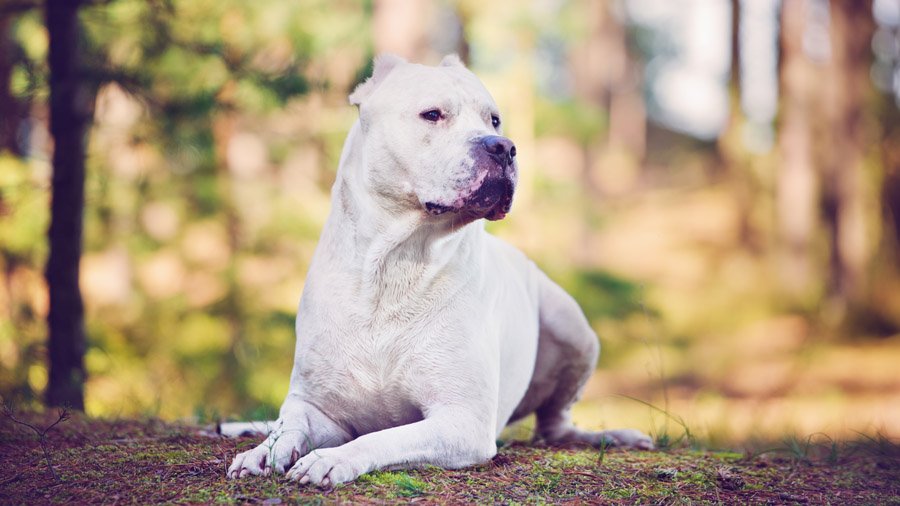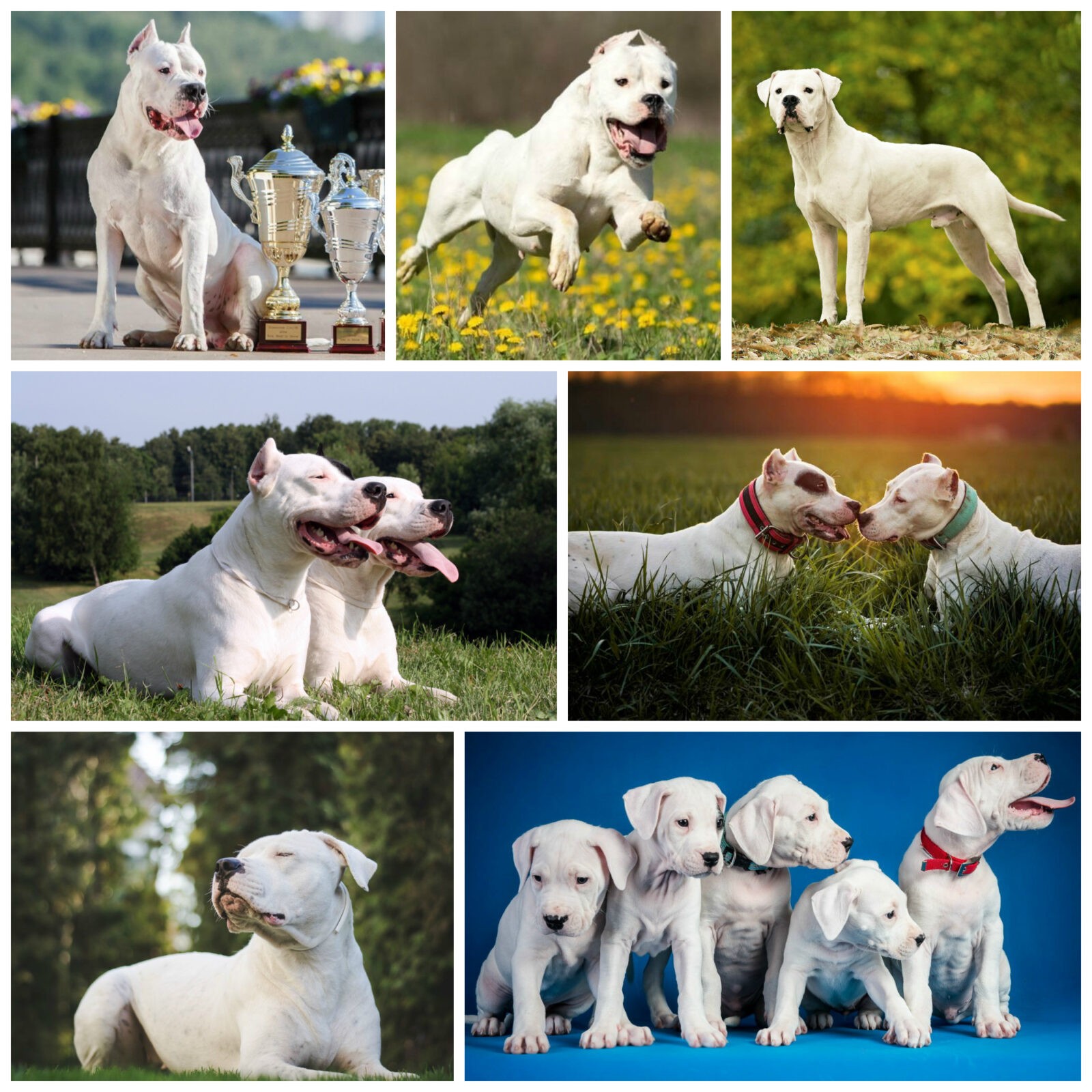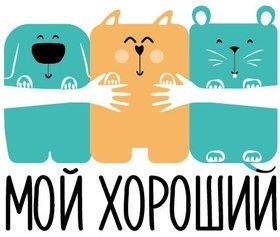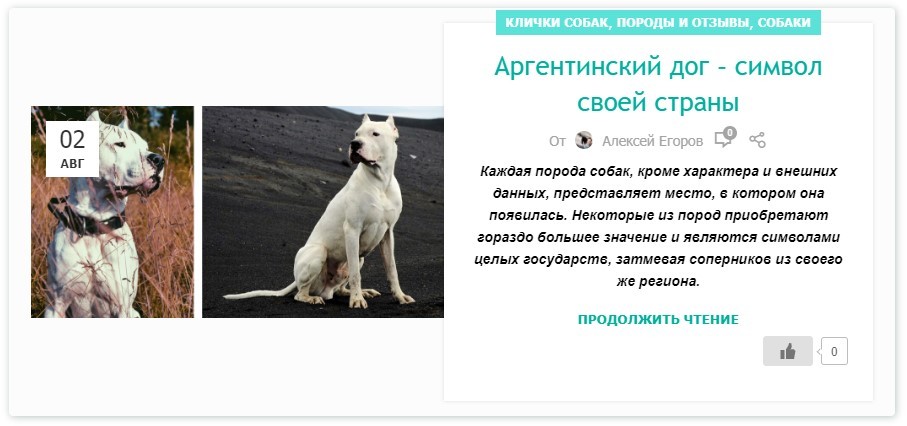White muscular Dogo Argentino, often also called Dogo Argentino or Argentine Mastiff, is a dog breed that belongs to the class of Great Dane Molossians (along with such giants as Neapolitan mastiff, rottweiler, Broholmer, etc.).

Brief description of the breed
Breed advantages
- Ideal guard dog;
- Does not have many health problems;
- Care does not require much time.
- Not suitable for inexperienced dog owners;
- Profuse salivation;
- Education should start at an early age;
- It is difficult to get along with other pets.
Heroes of this article - the first and only breed bred in Argentina and recognized by the Kennel Federation of the country in 1964. Today, dogs of this breed do an excellent job of guarding, help in hunting, and often successfully participate in battles with other breeds. Often, the Dogo Argentino is turned on as a strong and confident family friend. The main distinguishing features of the character of the Argentine mastiff - endurance, he never gives in to an opponent who even exceeds him in size and weight (fights with wild boars).
dogo argentino -big dogs, whose growth reaches 62-68 cm in males and 60-65 cm in females. Dogo Argentino's weight is also impressive - 45-65 kg in males, 40-55 cm in females.
basic information
| Breed name: | dogo argentino |
| Country of origin: | Argentina |
| The time of the birth of the breed: | 1928 |
| Type of: | Molossians |
| The weight: | 40 - 60 kg |
| Height (height at the withers): | 60 - 68 cm |
| Life Expectancy: | 10 – 14 years old |
|
ICF classification:
|
Group 2, Section 2, Room 292 |
| Puppies price: | 400 – 1800 $ |
| Most popular nicknames: | list of nicknames for dogo argentino |
Assessment of breed characteristics
| Adaptability
(a definition meaning how easily a dog can adapt to changes in life) |
🐶🐶🐶 |
| Shedding level
(Level and frequency of hair loss in the animal) |
🐶🐶🐶 |
| Tenderness level
(The level and amount of tenderness and affection that the dog gives in return for attention to itself) |
🐶🐶🐶 |
| Exercise needs
(Dog's daytime activity level) |
🐶🐶🐶🐶 |
| Social need
(The required number of contacts of the dog with other animals, as well as people) |
🐶🐶🐶 |
| Apartment content
(A factor that determines the level of noise and other inconveniences that a dog can deliver to owners in relation to the size of the apartment to the size of the dog) |
🐶 |
| Grooming
(The number of bathing, brushing, and the number of professional grooming sessions required for the dog) |
🐶 |
| Friendliness in an unfamiliar environment
(Features of the behavior of a dog in a society with strangers or in an unfamiliar environment) |
🐶 |
| Tendency to bark
(Tendency to bark and its frequency and volume) |
🐶🐶 |
| Health issues
(Potential health status of the dog) |
🐶🐶🐶 |
| Territoriality
(The dog's tendency to protect his home, yard, or even his owner's car) |
🐶🐶🐶🐶🐶 |
| Friendliness to cats
(The tendency towards tolerance for cats and decreased manifestation of hunting instincts) |
🐶 |
| Intelligence
(The ability of the dog to think and solve emerging difficulties (not to be confused with learning!) |
🐶🐶🐶 |
| Education and training
(The level of difficulty in training the dog to perform certain actions) |
🐶🐶 |
| Friendliness to children
(A factor that determines how friendly a dog is to children, whether he likes to play with them and tolerate some childish pranks) |
🐶🐶🐶 |
| Game activity
(The concept is determined by its very name, and, as a rule, is found in almost all dogs) |
🐶🐶🐶 |
| Observation
(The ability of a dog to detect the presence of a stranger on its territory) |
🐶🐶🐶🐶🐶 |
| Friendliness to other dogs
(The tendency of the dog to find common language with his other relatives) |
🐶 |
Appearance
Addition dogs are strong, with well-developed muscles. Head Dogo Argentino is of medium size, powerful, the cranial part of which is convex, with well-developed zygomatic arches and a depression in the frontal region, superciliary arches protruding. Nose and lips Great Danes have black pigmentation. Eyes widely set, small in size, most often dark or light brown. The head is connected with a strong neck medium length, with a small skin kit. Back the dog is broad, with well-developed muscles, evenly lowered in the lumbar region, the dorsal and vertebral muscles are strong, clearly defined. Tail saber-shaped, moderately long and wide in diameter. limbs long, muscular (especially posterior), straight, parallel. Wool Dogo Argentino is short (no more than 2 cm), smooth, white, sometimes with small marks of dark tones around the eyes.
Dogo Argentino photo:

The history of the origin of the Dogo Argentino breed
Despite the fact that Dogo Argentino gained popularity only in the second half of the 20th century, the history of their creation is quite long and complicated. One of the very first progenitors of the modern Dogo Argentino were mastiffs that appeared in South America in the 16th century. Their main goal was to serve the conquering conquistadors against the local population.
Massive and ready to fight to the end, mastiffs were gradually crossed with other breeds. - bulldogs, boxers. Puppies from such unions, which are called the white dog of Cordoba (white - thanks to the shade of the coat of puppies, Cordoba - due to its wide distribution in the region of the same name in Argentina) possessed cruel character traits, great physical strength and endurance.
In Argentina in general, and in Cordoba in particular, dog fights were extremely popular and spectacular, visitors to such fights - simple peasants rooted for the dogs so fiercely that they forgot all the hardships and the overwhelming burden of hard physical labor. The main purpose of such dogs until the beginning of the 20th century was participation in battles, until Professor A.N. became interested in the breed. Martinez, who later became the "father" of Dogo Argentino. The main idea pursued by Martinez was the creation of a dog, bold and strong, able to hunt big game and predators (peccaries, cougars, etc.). But hunting dogs were not supposed to be as bloodthirsty as the white dog of Cordoba.
To create the perfect hunting dog, which could also be an assistant in everyday life, Martinez crossed breeds such as: boxer, German and dogue de bordeaux, bull terrier, bulldog, Pointer, Pyrenean Mountain Dog, Spanish Mastiff, Irish Wolfhound. For a long time, puppies born had certain traits that would not allow them to become truly self-possessed and cold-blooded. For 3 decades, Professor Martinez brought his brainchild to perfection, until, finally, the Dogo Argentino dog breed was created.
In 1928, the first Standard was approved breeds, and 36 years later, after the death of A.N. Martinez, the Cynological Federation of Argentina officially recognized her. For a long time, Dogo Argentino were the property of the country, but did not have much popularity in Europe. Only in the 70s, Dogo Argentino began to attract the attention of dog breeders in Holland and Germany, and then in Austria, Spain, and Italy. In our country, dogs of this breed appeared for the first time in the early 90s. But the real homeland of these dogs - Argentina, where these animals are the hallmark of the country.
Dogo Argentino character
Maintenance and care
Dogo Argentino training and education
The training of the Argentine baby should begin literally from the first days of his stay in the house. These dogs are savvy and cunning enough to understand that the owner, who once gave up slack, allows himself to be twisted into ropes. You should not allow the little dog what will later be prohibited. Not later than 2 months, the puppy should begin to teach simple commands (“Come to me!”, “Fu!, etc.), then encourage if the baby has done everything correctly. While the puppy is small (especially if he will always live in an apartment), you should teach him how to walk as needed in a place strictly designated for this.
Always - both at home and on the street, the dog must listen to the owner, and for this to be the case, the animal should be raised from an early age. From six months you can think about dog training under the guidance of an instructor (especially when the dog will not only guard the house, but will also participate in the hunt), who will correctly point out the gaps in education and help correct them, explain all the subtleties of training dogs of this particular breed. By the time of training under the supervision of a specialist, the dog should have one person of his master in his authority, who taught him the basics of training and instilled good manners.
These dogs are highly trainable and receptive. They quickly pick up the commands of the owner, but long training sessions can quickly bore them. The owner must clearly, gently and persistently show that the dog should listen to him. But physical strength and screaming are excluded, since such an approach will completely kill all the dog's interest in training.
Health and disease of the Dogo Argentino breed
Some interesting facts
- In 2004, a film called "My friend- dogo argentino”, where, along with professional actors, Dogo Argentino himself participated in the filming. The drama co-produced by Argentina and Spain tells about the difficult fate of a man whose life takes on colors with the help of a true friend - an Argentinean dog named Bonbon. I must say that the animal coped with the role brilliantly.
- In Argentina, there is the largest number of nurseries of this breed, the largest of them - “De Agallas”, “De Urumpta”, “De el Tumi”, “de Coatro Soles”. Purchasing a puppy bred in one of these kennels is very costly and not a quick matter, since quivering Argentines consider dogs of this breed a symbol of their country and even for big money rarely agree to sell and export a puppy abroad.
Nurseries and breeders
We borrowed material from the wonderful site of our partners DOGCATFAN.COM about cats and dogs, the author dogcatfan

